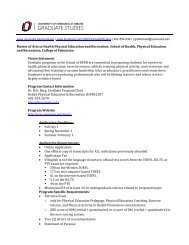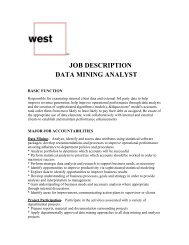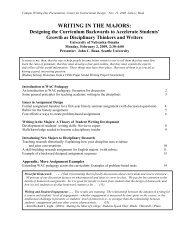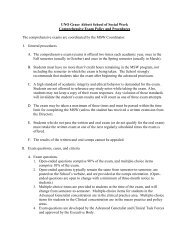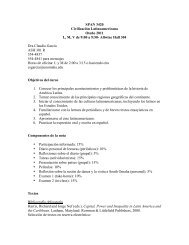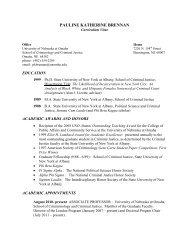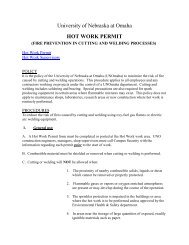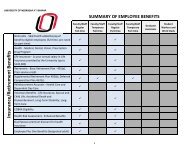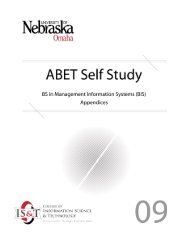The Role of the Endocrine System in Baboon Maternal Behavior
The Role of the Endocrine System in Baboon Maternal Behavior
The Role of the Endocrine System in Baboon Maternal Behavior
You also want an ePaper? Increase the reach of your titles
YUMPU automatically turns print PDFs into web optimized ePapers that Google loves.
M. Bardi et al BIOL PSYCHIATRY 2004;55:724–732 725<br />
(Bardi et al 2003a). Elevated prolact<strong>in</strong> and cortisol levels have<br />
been related to male parental care (Ziegler et al 2000).<br />
Both <strong>the</strong> direction and <strong>the</strong> extent <strong>of</strong> <strong>the</strong>se associations have<br />
generated problematic <strong>in</strong>terpretations, however, because a number<br />
<strong>of</strong> studies have failed to confirm those f<strong>in</strong>d<strong>in</strong>gs, <strong>of</strong>ten with<strong>in</strong><br />
<strong>the</strong> same species and when conducted by <strong>the</strong> same research<br />
groups. Although Bahr and colleagues orig<strong>in</strong>ally found an association<br />
between progesterone, cortisol, and a maternal competence<br />
score <strong>in</strong> gorillas (Bahr 1995; Bahr et al 1998), later<br />
expansion <strong>of</strong> <strong>the</strong>ir studies did not support a relation between<br />
hormonal levels and maternal behavior (Bahr et al 2001). Moreover,<br />
despite several studies po<strong>in</strong>t<strong>in</strong>g toward a role for ovarian<br />
steroid hormones <strong>in</strong> shap<strong>in</strong>g maternal behavior, Maestripieri and<br />
Megna (2000) failed to f<strong>in</strong>d a relation between peripheral ovarian<br />
steroid hormonal levels dur<strong>in</strong>g early lactation and <strong>in</strong>dividual<br />
differences <strong>in</strong> <strong>the</strong> maternal style <strong>of</strong> abusive and controll<strong>in</strong>g<br />
mo<strong>the</strong>rs. F<strong>in</strong>ally, whereas most studies revealed a positive association<br />
between elevated estrogen and maternal behavior, Fite<br />
and French (2000) found that estradiol levels were higher <strong>in</strong><br />
mo<strong>the</strong>rs <strong>of</strong> <strong>in</strong>fants who did not survive.<br />
Contradictory results exist <strong>in</strong> humans as well. Flem<strong>in</strong>g and<br />
colleagues reported that changes <strong>in</strong> maternal feel<strong>in</strong>g dur<strong>in</strong>g<br />
pregnancy were unrelated to <strong>the</strong> levels <strong>of</strong> pregnancy hormones<br />
or cortisol (Corter and Flem<strong>in</strong>g 1995) and that cortisol was not<br />
associated with attitud<strong>in</strong>al measures <strong>of</strong> maternal responsiveness<br />
(Flem<strong>in</strong>g et al 1997b). <strong>The</strong> same research group also found that<br />
<strong>the</strong> pattern <strong>of</strong> change <strong>in</strong> <strong>the</strong> ratio <strong>of</strong> plasma E 2 to progesterone<br />
from early to late pregnancy was related to postpartum attachment<br />
feel<strong>in</strong>gs (Flem<strong>in</strong>g et al 1997a) and that mo<strong>the</strong>rs with higher<br />
cortisol levels were more attracted to <strong>the</strong>ir own <strong>in</strong>fant’s body<br />
odor (Flem<strong>in</strong>g et al 1997b).<br />
A large body <strong>of</strong> human research on changes <strong>in</strong> hypothalamopituitary-adrenal<br />
(HPA) and hypothalamic-pituitary-gonadal<br />
(HPG) axes function<strong>in</strong>g dur<strong>in</strong>g pregnancy and <strong>the</strong> postpartum<br />
period has assessed <strong>the</strong>ir relation with mood, anxiety, and stress<br />
response, l<strong>in</strong>k<strong>in</strong>g <strong>the</strong>se two systems, albeit <strong>in</strong>directly, with<br />
parent<strong>in</strong>g behavior and <strong>in</strong>fant outcome. Susceptibility to psychosocial<br />
stressors dur<strong>in</strong>g lactation has been found <strong>in</strong> several<br />
studies, po<strong>in</strong>t<strong>in</strong>g toward a central mechanism that <strong>in</strong>fluences<br />
both reproduction and <strong>the</strong> hypothalamo-pituitary-adrenal HPA<br />
axis for mediat<strong>in</strong>g <strong>the</strong> effects <strong>of</strong> environmental challenges (Carter<br />
et al 2001). O<strong>the</strong>rs found that <strong>the</strong> degree <strong>of</strong> change <strong>in</strong> circulat<strong>in</strong>g<br />
hormones <strong>in</strong> response to happy and sad emotions was small and<br />
possibly not functionally significant (Turner et al 2002). F<strong>in</strong>ally,<br />
effects <strong>of</strong> <strong>the</strong> postpartum maternal endocr<strong>in</strong>e status have been<br />
significantly associated with <strong>the</strong> child’s temperament (Susman et<br />
al 2001).<br />
<strong>The</strong> baboon provides an excellent model for <strong>the</strong> study <strong>of</strong> <strong>the</strong><br />
endocr<strong>in</strong>ology <strong>of</strong> human pregnancy because <strong>the</strong> characteristics<br />
<strong>of</strong> <strong>the</strong> menstrual cycle <strong>in</strong> baboons are very similar to those <strong>of</strong><br />
women, and <strong>the</strong> pattern <strong>of</strong> estrogens and progesterone secretion<br />
are virtually identical (Stevens 1997). In addition, <strong>the</strong> baboon has<br />
a visually identifiable menstrual cycle and pregnancy status. <strong>The</strong><br />
goal <strong>of</strong> this study was to assess <strong>the</strong> relation between <strong>the</strong> overall<br />
endocr<strong>in</strong>e steroid changes dur<strong>in</strong>g <strong>the</strong> peripartum period and<br />
maternal behavior. Because adrenocortical activity is likewise<br />
affected by <strong>the</strong> changes <strong>in</strong> physiologic status that occur dur<strong>in</strong>g<br />
<strong>the</strong> peripartum period, we also evaluated <strong>the</strong> synergistic function<strong>in</strong>g<br />
<strong>of</strong> <strong>the</strong> HPA and HPG axes across parturition for its effect<br />
on <strong>the</strong> quality <strong>of</strong> maternal care <strong>in</strong> baboons. In particular, we<br />
tested <strong>the</strong> hypo<strong>the</strong>ses that maternal behavior is positively correlated<br />
with high values <strong>of</strong> <strong>the</strong> estrogen–progesterone balance, and<br />
that physiologic peripartum stress, as measured by cortisol levels,<br />
is negatively correlated with later mo<strong>the</strong>r–<strong>in</strong>fant levels <strong>of</strong> <strong>in</strong>teraction.<br />
This project was designed to account for multiple sources<br />
<strong>of</strong> variation and for <strong>the</strong> great physiologic and behavioral <strong>in</strong>dividual<br />
phenotypic plasticity us<strong>in</strong>g a large, extensively monitored<br />
subject pool. Because our aim was to compare two sets <strong>of</strong><br />
variables divided naturally <strong>in</strong> two groups, <strong>the</strong> endocr<strong>in</strong>e and <strong>the</strong><br />
behavioral sets, we used canonical correlation analysis to take<br />
<strong>in</strong>to account <strong>the</strong> complexity <strong>of</strong> <strong>the</strong> relations with<strong>in</strong> and between<br />
<strong>the</strong> two sets, thus consider<strong>in</strong>g for <strong>the</strong> first time <strong>in</strong> any primate<br />
species <strong>the</strong> overall association between hormonal levels and<br />
maternal behavior dur<strong>in</strong>g <strong>the</strong> late pregnancy–early lactation<br />
period.<br />
Methods and Materials<br />
Study Sample<br />
<strong>The</strong> subjects <strong>in</strong>clude 89 pregnant female savannah baboons<br />
(Papio hamadryas sp.) and <strong>the</strong>ir newborn <strong>of</strong>fspr<strong>in</strong>g. Females<br />
were <strong>of</strong> known l<strong>in</strong>eage and were between <strong>the</strong> ages <strong>of</strong> 5 and 20<br />
years (mean age 11.4 3.6 SD). All females were housed <strong>in</strong><br />
similar outdoor enclosures (47 m 2 ), <strong>in</strong>clud<strong>in</strong>g a heated sheltered<br />
area for <strong>the</strong> w<strong>in</strong>ter, at <strong>the</strong> Southwest Foundation for Biomedical<br />
Research, San Antonio, Texas. <strong>The</strong> enclosures had perches,<br />
sw<strong>in</strong>gs, and standard toys available at all times. Subjects lived <strong>in</strong><br />
social groups <strong>in</strong>clud<strong>in</strong>g one adult male and 8–20 adult females.<br />
Subjects were never transferred from a group to ano<strong>the</strong>r dur<strong>in</strong>g<br />
<strong>the</strong> course <strong>of</strong> <strong>the</strong> study, and <strong>the</strong>y were all born <strong>in</strong> captivity. <strong>The</strong><br />
subjects were part <strong>of</strong> a planned breed<strong>in</strong>g program and were not<br />
used for o<strong>the</strong>r research dur<strong>in</strong>g <strong>the</strong> course <strong>of</strong> <strong>the</strong> study. Offspr<strong>in</strong>g<br />
rema<strong>in</strong>ed with<strong>in</strong> <strong>the</strong> home cage until <strong>the</strong>y were weaned at <strong>the</strong><br />
age <strong>of</strong> 12–15 months. Animals were fed commercially available<br />
diet daily. Gra<strong>in</strong> was scattered <strong>in</strong> <strong>the</strong> cage daily, and water was<br />
supplied ad libitum.<br />
Dom<strong>in</strong>ance matrices were constructed us<strong>in</strong>g <strong>the</strong> prepartum<br />
data by consider<strong>in</strong>g <strong>the</strong> directionality <strong>of</strong> affiliative, submissive,<br />
and aggressive behaviors given and received by <strong>the</strong> subject and<br />
with all o<strong>the</strong>r adult <strong>in</strong>dividuals with<strong>in</strong> <strong>the</strong> social group. Social<br />
rank was fur<strong>the</strong>r determ<strong>in</strong>ed by <strong>the</strong> subject’s priority <strong>of</strong> access to<br />
a preferred food source (fruit), which was placed at <strong>the</strong> front <strong>of</strong><br />
<strong>the</strong> cage by <strong>the</strong> observer who <strong>the</strong>n recorded <strong>the</strong> order <strong>of</strong><br />
approach<strong>in</strong>g females. Each <strong>in</strong>dividual <strong>in</strong> each social group was<br />
<strong>the</strong>n ranked on a scale <strong>of</strong> high, medium, and low rank by<br />
evaluat<strong>in</strong>g <strong>the</strong> dom<strong>in</strong>ance matrices and food access.<br />
Gender distribution among <strong>the</strong> 89 newborns was homoge-<br />
neous (43 males, 46 females). <strong>Maternal</strong> rank and age were also<br />
homogeneously distributed <strong>in</strong> <strong>the</strong> sample ( 2<br />
[4] 2.1, ns), with<br />
no significant <strong>in</strong>teraction between <strong>the</strong>se two factors (r .1, n <br />
89, ns). <strong>Maternal</strong> experience, as represented by <strong>the</strong> number <strong>of</strong><br />
previous <strong>of</strong>fspr<strong>in</strong>g delivered, was also homogeneously distributed<br />
<strong>in</strong> <strong>the</strong> sample: <strong>the</strong> number <strong>of</strong> previous <strong>of</strong>fspr<strong>in</strong>g ranged<br />
between 1 and 9 (mean number <strong>of</strong> <strong>of</strong>fspr<strong>in</strong>g 4.8 2.1 SD). As<br />
expected, we found a significant association between age and<br />
number <strong>of</strong> previous <strong>of</strong>fspr<strong>in</strong>g (r .7, n 89, p .05).<br />
Data Collection<br />
Each subject was monitored for pregnancy by record<strong>in</strong>g<br />
changes <strong>in</strong> <strong>the</strong> gender sk<strong>in</strong> size and color. <strong>The</strong> scor<strong>in</strong>g <strong>of</strong> <strong>the</strong><br />
gender sk<strong>in</strong> swell<strong>in</strong>g (on a scale <strong>of</strong> 1–4 plus menstruation) was<br />
used to <strong>in</strong>dicate <strong>the</strong> menstrual cyclicity (Hendrickx 1965). Pregnancy<br />
was <strong>the</strong>n determ<strong>in</strong>ed start<strong>in</strong>g when <strong>the</strong> normal cycl<strong>in</strong>g<br />
was <strong>in</strong>terrupted and choos<strong>in</strong>g <strong>the</strong> estimated date <strong>of</strong> parturition as<br />
185 days after <strong>the</strong> last day <strong>of</strong> fully swollen gender sk<strong>in</strong>. <strong>The</strong><br />
average estimated data <strong>of</strong> parturition was with<strong>in</strong> 5 days <strong>of</strong> <strong>the</strong><br />
www.elsevier.com/locate/biopsych




